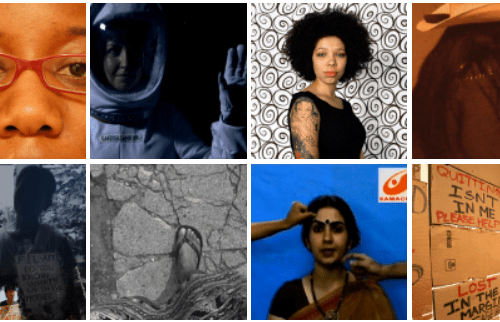Epigenetic Robotics
The Subservient Chicken website provides an uncanny bridge between Waddington’s contribution to the second Serbelloni Symposium and the current entanglement of cybernetics and epigenetics. In the last ten years, epigenetics has been picked up by the discipline of robotics, completing the circle of Ouroboros. This new field of epigenetic robotics incorporates the stress on reflexivity characteristic of third-order cybernetics. As Christopher G. Prince, Nathan A. Helder, and George J. Hollich argued in 2005 to an audience at the Fifth International Workshop on Epigenetic Robotics, “Epigenetic robotics is a new field that focuses on modeling cognitive development and creating robots that show autonomous mental development.”83 Differentiating between the top-down design of existing robotics and the unfolding developmental processes exhibited by the human infant, they diagnose contemporary robotics as merely “demonstrating emergence but not ongoing emergence,” a quality they claim as central to their field. Prince et. al. establish ongoing emergence as the core concept of the field, and enumerate the six criteria integral to that concept: “(1) continuous skill acquisition, (2) incorporation of new skills with existing skills, (3) autonomous development of values and goals, (4) bootstrapping of initial skills, (5) stability of skills, and (6) reproducibility.”84
Note, however, that in defining the field and itemizing the skills that epigenetic robotics needs to learn from human babies, these epigenetic roboticists perform a narrowing of focus similar to Waddington’s pivotal exclusion of affect in the Serbelloni Symposium talk. By characterizing the field as “modeling cognitive development and creating robots that show autonomous mental development,”(my italics) they implicitly exclude the relational, interdependent, and affective aspects of development, whether human or robotic.85 And they make this exclusion while claiming for themselves the label of “epigenetic robotics.” In so doing, they demonstrate “the inhibition of affect,” the “scorn for psychological interiority,” and the inability to conceptualize genuine, two-way interactivity that characterized the development of artificial intelligence in the wake of its turn from the original embodied, affective, and erotic vision of Alan Turing.86
Back to the Past (and Future)
Karen Barad’s analysis of the implications of quantum discontinuity for our understanding of time provides the epigraph for this essay. I have also mentioned her insight that “the past is never left behind.” Yet in a passing comment following her keynote presentation at the Society for Literature, Science, and the Arts conference in 2010, Barad defined the stakes in returning to the world egg and the Ouroboros for feminist science studies: “The past hasn’t happened yet.”87 In returning to the 1967 second Serbelloni Symposium and reopening a part of the past we had thought was closed, I have been mindful of Sarah Ahmed’s charge that feminist new materialists distribute our love unequally, skimping our mothers to lavish attention on our forefathers. So, let us move from Waddington, who, as we see, evaded the full implications of the Ouroboros—that “any one entity incorporates into itself in some sense all the other entities in the Universe”—to Marjorie Grene. At Serbelloni, she voiced an alternative model for conceptualizing and operationalizing epigenetic emergence that extends, and perhaps mends, Waddington’s partial vision.88 Recall that challenging the conventional model of biological theory, with its fascination for the arid machine of computation for computation’s sake, Grene argued instead that “emergent orders […] have to be apprehended, not through manipulation of means […] but through understanding.”89 Perhaps precisely because she was as maverick to orthodox philosophy as Waddington was to mainstream biology, Grene articulated an embedded, embodied, and emergent vision of development.
Grene’s personal experiences and environment afforded her the capacity to use what she found around her—in philosophy, biology, and other fields. Let me explain. Marjorie Grene had spent much of her career on a working farm, unlike (as she put it) “most philosophers, [who] I have found, live in a philosopher’s room, where all apertures have been hermetically sealed against reality and only recent copies of a few fashionable philosophical journals are furnished to the inhabitants.”90 Therefore, her vision of philosophy was flavored with that unorthodox awareness of the role of nature in her life. When she set forth her “ecological epistemology” in her eighties, writing in A Philosophical Testament, her “apologia pro philosophia sua,” she emphasized the crucial developmental role played by the place where one lives. The volume opens with sections on “Knowing” and “Being,” but it concludes with the most evocative section, on “Coping:”
To be alive is to be somewhere, responding somehow to an environment, and in turn shaping that environment by our way of coping with it. To study human practices, including language, as forms of life is to study them as activities of the particular sort of animal we find ourselves to be […] To think of ourselves as alive, as part of the living world, it is not necessary to know a lot about biology. It is just necessary not to reduce everything there is to either machines or feelings (or to machines, feelings, or verbiage). In short, let us put what we feel, what we do, what we apprehend around us, back into the living world, where it belongs.91
Grene’s choice of the word “coping” includes the embodied and affective aspects of experience, but it also demonstrates the influence of an encounter that took place just two years after the second Serbelloni Symposium. In 1969, Grene and Hubert Dreyfus collaborated in mounting “one of those large amorphous, or polymorphic, meetings,” (she wrote in 1995) “that don’t, I think by now, do anyone much good”—on the topic “Concepts of Mind.”92 The two conference organizers were preoccupied in Berkeley in 1969 with some of the same ideas that had circulated at Bellagio two years earlier. As she recalled in A Philosophical Testament, “Bert has a long-term love-hate relationship with the philosophical aspects of work in Artificial Intelligence, and I was concerned, chiefly in connection with philosophical questions about biology, with the problem of reductionism as it was then debated: is biology reducible to physics and chemistry, are minds reducible to nervous systems, and so on.”92 The outcome would be significantly different.
At that Concepts of Mind meeting, Marjorie Grene first encountered the ecological psychologists James J. Gibson and Eleanor J. Gibson. Grene details her belief that the Gibsons’ ecological psychology could “contribute to a new and more fruitful account of animals, and particularly human animals’, knowledge of their world.” From 1969 to 1995, when she published A Philosophical Testament, Grene developed a philosophy of biology deeply influenced by two notions drawn from the Gibsons: the notions of invariants and affordances. Grene explains these terms in APT by explaining the three components common to all perception: “the things and events in the organism’s environment; second, the information available for pickup by the organism, usually in the form of invariants: constant mathematical ratios within a flowing array, and third, what the organism uses its information pickup to perceive: the affordances that the environment offers it.”93 While this model recalls, on a larger scale, the enmeshed relations between organism and environment that Waddington explored in his theory of epigenesis, it differs from it in one signal way: it levels the encounter between human beings, animals, and other parts of living nature to one lateral plane. What she has drawn from the Gibsons is the refusal of a hierarchical relationship between of human life and knowledge and animal life and knowledge. Her explanation is worth citing at length:
For Gibson (or the Gibsons), on the contrary, as human reality is one version of animal reality, so human knowledge is one species-specific version of the ways that animals possess to find their way around their environments. Granted, our modes of orientation in our surroundings are peculiarly dependent on the artefacts of culture. […] But culture, rather than being a mere addendum to nature . . . is itself a part of nature. There is no culture, and therefore no human reality, and a fortiori no human knowledge, not dependent on the use of natural materials and itself contained in nature, in the natural environment mother earth, on whose existence we all depend.94
How we interpret the second Serbelloni Symposium—whether we blame Waddington for missing the full implications of the metaphysical insights he embodied in the images of the world egg and the Ouroboros, or for dismissing Grene’s critique with a joke—depends on how we understand relationship of Waddington and Grene to their environments. Paying attention to the curious image from Waddington’s talk has led me to look closely at the second Serbelloni Symposium. And paying attention to the debate that ensued there concerning the various formulations of theoretical biology has led me to Marjorie Grene and her contribution to the philosophy of biology. We might indeed claim her as a precursor of feminist science studies, and perhaps even of feminist new materialism. “What counts as biology and materiality within the sciences is after all a subject of debate and dispute,” Ahmed observes.95 One could also venture an analogous statement: What counts as theory—within biology and within feminism—is also, after all, a subject of debate and dispute. And happily so.
- Christopher G. Prince, Nathan A. Helder, & George J. Hollich, “Ongoing Emergence: A Core Concept in Epigenetic Robotics,” ed. L. Berthouze, et. al. Proceedings of the Fifth International Workshop on Epigenetic Robotics: Modeling Cognitive Development in Robotic Systems (University Cognitive Studies, 2005) 123. [↩]
- Prince et al. 2005: 123. [↩]
- Prince et. al. 2005: 1. [↩]
- Elizabeth Wilson, Affect and Artificial Intelligence (Seattle: U of Washington P, 2010): 82. Even Kismet, the robot modeled explicitly on a human child, exhibits “a drive-dependent, cognitively oriented, shameless affectivity […] more faithful to a classical AI paradigm.” There is much more to this story. “Turing’s loss of nerve” not only led to the exclusion of Eros and affect, but in the emphasis on the digital also excluded the analog mode, and thus the relationship between affect and the body, as well as the more complex, non-binary states such as “helplessness, confusion, and error.” [↩]
- Karen Barad, personal communication, SLSA Convention, Atlanta, GA, 2010. [↩]
- Waddington 1969: 73. [↩]
- Grene 1969: 61. [↩]
- Phil Mullins, “Vintage Marjorie Grene,” Tradition and Discovery 27.1 (2000): 35. [↩]
- Grene 1995: 63-4. [↩]
- Grene 1995: 130. [↩] [↩]
- Grene 1995: 143. [↩]
- Grene 1995: 144. [↩]
- Ahmed 2008: 35. [↩]




